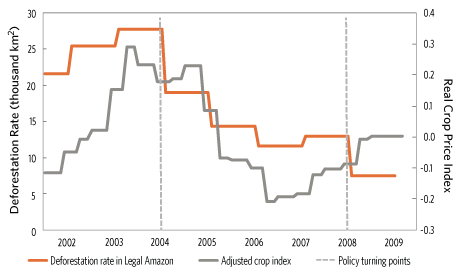The second half of the 2000s witnessed a sharp decrease in total deforestation rate in the Brazilian Amazon. In only five years, the pace of forest clearings dropped from an alarming peak of approximately 27,000 km2 in 2004 to about 7,000 km2 in 2009. While the numbers sound like good news for conservation efforts in Brazil, many wonder what led to such a dramatic decline in deforestation. What were the underlying forces driving this sudden change in behavior? With the Brazilian Ministry of Environment currently conducting the second revision of its strategic Action Plan for the Prevention and Control of Deforestation in the Legal Amazon (PPCDAm), the answer to this question will be useful to policymakers in Brazil, as well as in other countries.
For the executive summary and full working paper version of the study, please click here. At CPI Rio, we investigated two alternative explanations for the slowdown in deforestation: market conditions and conservation policies. On the one hand, falling agricultural prices may have inhibited the clearing of forest areas for the expansion of farmland. On the other hand, conservation policies introduced in the second half of the 2000s may have contributed to the curbing of deforestation. Using regression techniques to disentangle the impacts of policies from those of other potential explanatory factors, such as agricultural price cycles, we assessed the contribution of Brazil’s policies to decreased deforestation rates. Our analysis shows that approximately half of the deforestation that was avoided in the Amazon in the 2005 through 2009 period can be attributed to the conservation policies introduced in the second half of the 2000s. The reduction in deforestation is equivalent to an avoided loss of 62,000 km2 of forest area, or approximately 620 million tonnes of stored C (2.3 billion tonnes of stored CO2), which our estimates value at 11.5 billion US dollars
At CPI Rio, we investigated two alternative explanations for the slowdown in deforestation: market conditions and conservation policies. On the one hand, falling agricultural prices may have inhibited the clearing of forest areas for the expansion of farmland. On the other hand, conservation policies introduced in the second half of the 2000s may have contributed to the curbing of deforestation. Using regression techniques to disentangle the impacts of policies from those of other potential explanatory factors, such as agricultural price cycles, we assessed the contribution of Brazil’s policies to decreased deforestation rates. Our analysis shows that approximately half of the deforestation that was avoided in the Amazon in the 2005 through 2009 period can be attributed to the conservation policies introduced in the second half of the 2000s. The reduction in deforestation is equivalent to an avoided loss of 62,000 km2 of forest area, or approximately 620 million tonnes of stored C (2.3 billion tonnes of stored CO2), which our estimates value at 11.5 billion US dollars

